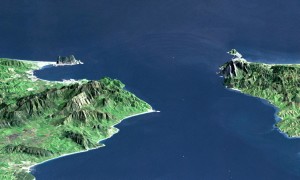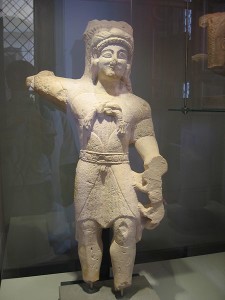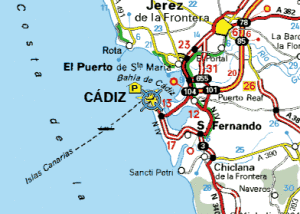Gadeirus
Strait of Gibraltar
The Strait of Gibraltar according to Greek mythology was created by Herakles. Neville Chipulina explains that “it seems that the person responsible for the myths about Hercules was Peisander of Rhodes, a 7th century BC Greek epic poet who apparently got the story from an unknown Pisinus of Lindus who almost certainly plagiarised it from somebody else. In other words, it’s a pretty old story.”(c)
The Strait is very much a part of many current Atlantis theories. Primarily, it is contended that the region itself held the location of Atlantis. This is based on Plato’s statement that Eumelos, also known as Gadeirus, the twin brother of Atlas the first king of Atlantis gave his name to Gades, known today as Cadiz. Andalusia in Southern Spain has been the focus of attention for over a hundred years. In recent years Georgeos Diaz-Montexano and his rival Jacques Colina- Girard have been investigating the waters of the Strait itself while south of the Strait Jonas Bergman has advanced his theory that Atlantis was located just across the Strait in Morocco.
Although there is general acceptance that the Pillars of Heracles had their final resting place in the vicinity of the Strait of Gibraltar, it must be noted that there have been other candidates at different times with equally valid claims. The location of the ‘Pillars’ referred to by Plato at the time of Atlantis is the subject of continuing debate.
>Archaeologist Josho Brouwers has noted(g) that “according to Strabo (3.5.5), Hercules raised the Pillars during one of his Twelve Labours to mark the western edge of the inhabited world. One pillar was identified as the Rock of Gibraltar (called Mount Calpe in ancient times), with the other was Ceuta (Mount Abile) on the African side of the narrow strait.
Diodorus Siculus mentions that Hercules put the Pillars in place as a monument to himself (4.18.4). He also adds that Hercules either narrowed the passage in order to prevent sea-monsters from the Atlantic to enter the Mediterranean, or to actually open the mountain so that the Atlantic could mingle with the Mediterranean. On this issue, as Diodorus puts it, “it will be possible for every man to think as he may please” (4.18.5).” For me it raises a warning flag regarding the hasty acceptance of ancient myths and traditions as having an historical basis.<
Strato, the philosopher, quoted by Strabo, spoke of a dam separating the Atlantic and the Mediterranean being breached by a cataclysm. This idea was reinforced by comments of Seneca. Furthermore, a number of Arabic writers, including Al-Mas’udi, Al-Biruni and Al-Idrisi, have all concurred with this idea of a Gibraltar land bridge in late prehistory.
A more radical theory is that of Paulino Zamarro who contends that the Strait was in fact closed by a landbridge during the last Ice Age because of the lower sea levels together with silting. When the waters rose and breached the landbridge, he believes that the flood submerged Atlantis, which he situates in the Aegean. Others support Zamarro’s idea of a Gibraltar Dam amongst whom are Constantin Benetatos and Joseph S. Ellul.
Terry Westerman on his heavily illustrated website surveys impact craters globally. He suggests that “The Strait of Gibraltar was formed by two meteor impacts. The first blasted the round area in the western Mediterranean Sea to form a land bridge between Spain and Morocco.” He maintains that a second impact broke the landbridge around 5.33 million years ago, creating what is called the Zanclean Flood which refilled the then desiccated Mediterranean(d).
A German-language website(a) presented some of the following data+, apparently recording the dramatic widening of the Strait of Gibraltar between 400 BC and 400 AD. The same list was included in the ‘Strait of Gibraltar’ entry of the German Wikipedia(b) until a few years ago. It has since been removed.
Alexander Braghine offered [156.139] similar data*, which, unfortunately, is also unreferenced.
+Damastes of Sigeum, circa 400 BC. – about 1.3 km
+Pseudo-Skylax, probably fourth Century BC – about 1.3 km
*Turiano Greslio? 300BC – 8.0 km
*+Titus Livius (Livy) 59 BC- 17 AD – 10.5 km
+Strabo 63 BC- 24 AD – from 9.5 to 13.0 km
+Pomponius Mela , 50 AD – about the 15.0 km
+Pliny the Elder, 50 AD – about 15.0 km
*+Victor Vicensa (*Vitensa?), 400 AD – about 18 km
Procopius, 550 AD – about 15.0 km
The above figures suggest that in the latter half of the first millennium BC, the Strait of Gibraltar was gradually widened. However, the figures given suggest that between 400 and 550 AD the Straits narrowed again seems absurd. Nevertheless, until the methods used and all the data on offer have been verified, the idea must be treated with great caution.
My list had originally included Euctemon, the 5th century BC Athenian astronomer, however, Werner E. Friedrich notes that Euctemon was referring to the Sea of Marmara near the entrance to the Black Sea [0695.38].
However, more recently, John Jensen Jnr. has offered a comparable, if shorter, number of dates showing the reducing width of the strait the further back you go, from which he extrapolated that around 3450 YBP when he believes that a landbridge there was breached(e).
Georgeos Diaz-Montexano has also referred to the descriptions by ancient writers of the Strait of Gibraltar indicating a width of around two kilometres. Unfortunately, he does not cite references(f). He also is sympathetic to the existence of an earlier landbridge at Gibraltar.
(a) https://de.academic.ru/dic.nsf/dewiki/1337738
(b) https://de.wikipedia.org/w/index.php?title=Stra%C3%9Fe_von_Gibraltar&oldid=60093153
(c) https://gibraltar-intro.blogspot.ie/2015/10/bc-pillars-of-hercules-if-ordinary.html
(d) The Formation of the Strait of Gibraltar (archive.org)
(e) https://www.migration-diffusion.info/article.php?id=514
(f) https://web.archive.org/web/20200630064033/http://freerepublic.com/focus/f-news/1011563/posts
(g) The Pillars of Hercules – Ancient World Magazine *
Melqart
Melqart was the son of El the supreme deity of the Phoenicians. He was the  principal god of the city of Tyre and was sometimes known as Baal. As Tyre gained supremacy throughout the Phoenician world, Melqart also gained prominence. Melqart is the only Phoenician god mentioned in the Hebrew Bible. The Temple of Melqart in Tyre was similar to that built for Solomon in Jerusalem. This is understandable as craftsmen from Tyre built the temple in Jerusalem and there would have had a natural exchange of religious ideas, as they were neighbours. Herodotus describes the main entrance to the sanctuary as being flanked by two columns or pillars known as ‘betyls’, one made of gold and the other of ‘smaragdus’— often translated as ‘emerald.’
principal god of the city of Tyre and was sometimes known as Baal. As Tyre gained supremacy throughout the Phoenician world, Melqart also gained prominence. Melqart is the only Phoenician god mentioned in the Hebrew Bible. The Temple of Melqart in Tyre was similar to that built for Solomon in Jerusalem. This is understandable as craftsmen from Tyre built the temple in Jerusalem and there would have had a natural exchange of religious ideas, as they were neighbours. Herodotus describes the main entrance to the sanctuary as being flanked by two columns or pillars known as ‘betyls’, one made of gold and the other of ‘smaragdus’— often translated as ‘emerald.’
The cult of Melqart was brought to Carthage, the most successful Tyrian colony, and temples dedicated to Melqart are found in at least three sites in Spain; Gades (modern Cadiz), Ebusus, and Carthago Nova. Near to Gades, at the Strait of Gibraltar, the mountains on either side were first known as the Pillars of Melqart, and then later changed to the Pillars of Heracles. Across the Strait of Gibraltar, at the Atlantic coast of Morocco was the Phoenician colony of Lixus, where there was another temple of Melqart.
In classical literature, Melqart and Heracles have been referred to interchangeably, by many historians such as Josephus Flavius.
It is thought that the city of Cadiz was originally founded as Gadir (walled city) by the Phoenicians around 1100 BC, although hard evidence does not prove a date earlier than the 9th century BC. In his 2011 book, Ancient Phoenicia, Mark Woolmer has claimed [1053.46] that the archaeological evidence indicates a date around the middle of the 8th century BC.
It is regarded as the most ancient functioning city in Western Europe. Gadir had a temple that was dedicated to the Phoenician god Melqart. Some consider that the columns of this temple were the origin of the reference of the Columns of Heracles. Commentators on Plato’s Atlantis story have linked Cadiz (formerly Gades) with the second son of Poseidon, Gadirus.
Hennig, Richard
Richard Hennig (1874-1951) was a German student of ancient geography. He drew on the work of Adolf Schulten and Otto Jessen to support his conviction that the Scheria referred to by Homer was in fact Atlantis. Hennig drew up a list of similarities between the two[613] but as N. Zhirov remarked, an equally long list of discrepancies could be compiled leaving the question still open.
In 1925, Hennig argued forcefully that Atlantis had controlled Cádiz in Spain where Tartessos was located. He claimed to have demonstrated that the Atlantean kingdom of Gadeirus controlled Atlantic Spain during pre-Classical times.
Eberhard Zangger noted [483.109] that in a 1927 article Hennig “investigated the root of the term ‘the Pillars of Heracles‘ and concluded that it was not initially applied to the Straits of Gibraltar but to another locality at the end of the Greek sphere of influence.”
Hennig also saw similarities between Atlantis and Tartessos and believed that the Greeks of Plato’s era thought of Tartessos as having disappeared no more than a hundred years earlier. This idea would have placed the demise of Tartessos/Atlantis around 500 BC, in other words after Solon’s visit to Egypt!
According to Atlantisforschung.de, “It should be noted that Richard Hennig later apparently turned away from the ‘Tartessos = Atlantis’ assumption and ‘converted’ to the Heligoland localization of Pastor Jürgen Spanuth, who said with satisfaction: ” After Hennig got to know my work, he wrote he said that he had completely changed his opinion and agreed with my views ‘completely’. So Hennig also came to the conclusion that the Basileia of the Atlantis report is identical to the Basileia of the Phaeacia and the Basileia of the Pytheas report, which are in the The mouth of the Eider lay on this side of Helgoland “.(a)
(a) Richard Hennig – Atlantisforschung.de (atlantisforschung-de.translate.goog) *
Cádiz
Cádiz is the modern name for ancient Gades considered the original kingdom of Gadeirus the twin brother of Atlas. However, the certainty normally associated with this accepted identification is weakened by the fact that quite a number of locations with similar-sounding names are to be found in the Central and Western Mediterranean regions.
A Map of Cadiz circa 1813 is shown on the right.
It has also been suggested that the name Cadiz came from Gadir, which in turn was derived from Kadesh!
 The Spanish historian, Adolfo Valencia wrote a history of Cádiz[0208], in which he suggested that Atlantis might have extended from Cádiz to Malta.
The Spanish historian, Adolfo Valencia wrote a history of Cádiz[0208], in which he suggested that Atlantis might have extended from Cádiz to Malta.
In 1973, Maxine Asher led an expedition to search for Atlantis off the coast of Cadiz, which despite claims of having discovered Plato’s Island, nothing verifiable was found(a). These claims received global press attention, enabling Asher to dine out on it for the rest of her fraudulent life.
It is generally accepted that the Phoenicians from Tyre founded Gadir, later to be known as Gades to the Romans. The Roman historian, Velleius Paterculus (c.19 BC – c.31 AD) wrote that Cadiz was founded 80 years after the Trojan War, circa 1100 BC. In the 9th century BC, the Phoenicians, under Princess Dido, founded a new capital at Carthage in North Africa. At Gades, the Phoenicians/Carthaginians built a temple to Melqart that had two columns that many consider to be the original Pillars of Hercules. In 2007, it was announced that excavations in the old town centre produced shards of Phoenician pottery and walls dated to the 8th century BC, probably making it the oldest inhabited city in Europe.
In early January 2022, “Archaeologists from the University of Seville and the Andalusian Institute of Historical Heritage claim to have discovered the lost Temple of Hercules Gaditanus. Using information they obtained from documentaries and aerial photographs, the researchers found a large rectangular structure submerged in the Bay of Cadiz. (b)
The structure, nearly 1,000 feet long, 500 feet wide, and matches the ancient descriptions of the temple, is only visible in low tide.”
In September 2023, the latest attempt to revive interest in a Spanish Atlantis was unveiled at a press conference in Chipiona, near Cádiz. The theme of the conference was the discovery of long underwater curved walls that some have claimed to match exactly Plato’s description of Atlantis.
Thorwald C. Franke(c) has more on the background to this effort to put the spotlight on the possibility of Atlantis being situated in this region of Spain which lies at the southern end of the Doñana Marshes that had received extensive investigation over the past couple of decades. The press conference was also used to announce the showing of a new documentary series by Michael Donnellan on October 8th in Cádiz.
Also See: Egadi Islands
(a) 1973 Atlantis Expedition (fourth-millennium.net)
(b) Spanish Archaeologists Claim to Have Discovered The Temple of Hercules (sputniknews.com)
Gades
Gades is the Roman name of what is generally accepted as having been located at or near modern Cadiz in southern Spain. In his Critias, Plato relates that the twin brother of Atlas, the first ruler of Atlantis, was named Gadeiros although known in Greek as Eumelos. It is assumed that he had his realm in the vicinity of Cadiz and had his capital named, Gadeira, after him.
However, it has been pointed out that the Phoenicians who, before the time of Plato, possessed a port city in southwest Spain named Gadir meaning ‘enclosure’ or ‘fortress’ and was, over time, corrupted to Cadiz.
 Until recently it was generally accepted, based on classical writers including the historian Livy, that the Phoenicians founded Gades around 1100 BC. Writers today such as Mark Woolmer have pointed out [1053.46] that the archaeological evidence suggests a more recent date, perhaps the middle of the 8th century BC.>>Around 500BC it was occupied by the Carthaginians and after that, eventually became Romanised.<<
Until recently it was generally accepted, based on classical writers including the historian Livy, that the Phoenicians founded Gades around 1100 BC. Writers today such as Mark Woolmer have pointed out [1053.46] that the archaeological evidence suggests a more recent date, perhaps the middle of the 8th century BC.>>Around 500BC it was occupied by the Carthaginians and after that, eventually became Romanised.<<
However, a number of locations with similar-sounding names are to be found in the Central and Western Mediterranean region, weakening the certainty normally associated with the more generally accepted identification of Gadeirus’ city with South-West Spain.
Another solution has recently been proposed by the late Michael Hübner, in which he offers the Souss-Massa plain of Southern Morocco as the location of Atlantis. On the Atlantic coast of the plain is the large town of Agadir, whose name is also probably derived from the word ‘gadir’ which means fort or enclosure in the local Tamazight language. It can also mean ‘sheep fold’, which may tie in with Plato’s use of ‘Eumelos’ as the Greek translation of Gadeiros means ‘rich in sheep’.
Alternative suggestions have been proposed, including one by Andis Kaulins(a), who is inclined to identify the islands of Egadi (Aegadian), off the west coast of Sicily, which is opposite today’s Tunis. Should this Egadi be the original Gades it would make sense for two of the suggested alternatives for the location of the Pillars of Heracles, either the Strait of Messina or the Strait of Sicily, where there is a Gadir on the island of Pantelleria(b). It would mean that Egadi would have been outside the Pillars of Heracles from either an Athenian or Egyptian perspective. Albert Nikas has pointed out the existence of a place in Malta called Il Ghadira, which has the largest sandy beach on the island!
A number of investigators have also identified Gades with Tartessos, presumed to be the Tarshish of the Bible.
More recently Jonathan Northcote has suggested that Gadeira may have been Ireland, citing Strabo, who quoted Eratosthenes, who had noted that Gades is five days sailing from the ‘Sacred Promontory’. Wikipedia lists(d) eleven promontories stretching from Crimea to Wales that have been so named, but notes that these were only some of the locations given that designation. So he arbitrarily chose either of the two Portuguese Capes listed as the most likely starting point for a five-day journey to Ireland (Gadeira)!
Stuart L. Harris has echoed this, employing linguistic gymnastics(c). He uses Felice Vinci‘s idea that Homeric Greek was in fact a form of Finnish and so Gadeira was Käde Eiran, meaning ‘Hand of Eira’, supposedly a variant of Éire (Ireland) and consequently Atlantis lay to the west of Ireland. Convoluted, is an understatement.
(a) Pillars of Heracles – Alternative Location (archive.org)

